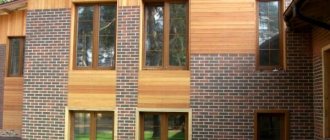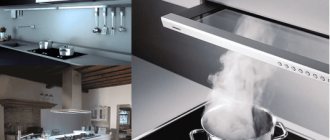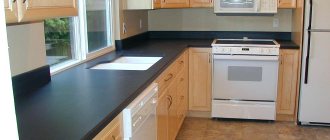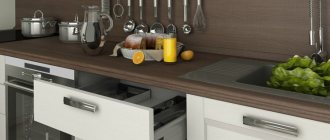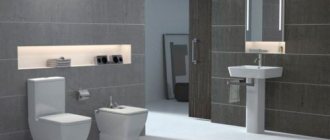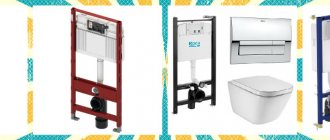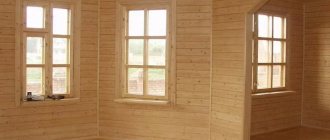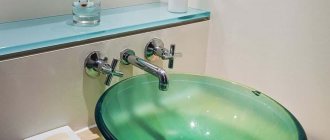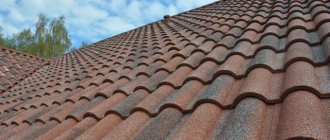A range hood is a must-have element in the kitchen. It allows you to clean the air from combustion products, fumes and odors generated during the cooking process. In addition, this device prevents grease and soot from settling on pieces of furniture.
A lonely hanging hood does not look very aesthetically pleasing and can ruin the look of any kitchen set. Therefore, it is built into a special module - a cabinet under the hood.
A competent approach to choosing a hood
Buying a built-in hood for the kitchen that fully matches its size and the dimensions of the unit is not as simple as, for example, a TV. Here it will not be enough to have a rough idea of which design is suitable and which one will need to be rejected.
It is also important to take into account a wide range of technical characteristics, installation and connection requirements, and the subtleties of adjusting operating modes.
It should be noted that studying these points will not take much time and in the future will allow you to clearly understand what exactly this unit is capable of and how it should be operated.
Compact and reliable built-in hoods are especially widespread today, and therefore it is their capabilities that it is advisable to study first.
Components
There are some options that will also be useful to housewives: for example, an anti-return valve that prevents the penetration of street air (the air entering the apartment through the ventilation does not have pleasant refreshing properties and sometimes just has a disgusting smell).
The body is also an important element of the product. If it is not easily soiled, then the owner will no longer need to wipe the panel and adjacent elements daily.
Backlight. For many cooks, light plays an important role (additional lights will help control the cooking process in a poorly lit room).
Hood with lighting
Exclusive design of the hood with lighting
Functional built-in hood with lighting
Much better than standard ventilation
It must be said that no alternatives to such a device can currently be found. A typical ventilation system opening onto the roof will, of course, create the necessary air circulation.
However, it will not adequately remove strong odors from meat and fish. But it is precisely these that need to be pumped out onto the street as soon as possible, which will only be possible with equipment specially created for this purpose.
Ostrovnaya
The most unusual hood, it is perfect for a large kitchen. As a rule, it is placed above the stove, which in turn is installed in the center of the kitchen. This type of hood not only purifies the air, but also serves as decoration.
A wide range of obvious advantages
A kitchen hood built into a cabinet has a number of positive and negative aspects. Their list greatly depends on how exactly a particular model is designed.
Among the main advantages of built-in hoods over analogues are the following:
- The built-in hood is designed in such a way that only the part that pumps air masses into the ventilation duct is visible. More traditional classic and island hoods quite spoil the interior, as they clutter it with their massive wide bodies. On top of that, a considerable amount of space must be allocated for their placement, and the built-in modification is simply hidden behind the walls of the kitchen unit;
- The working surface can be adjusted over a wide range of values. Thanks to the presence of retractable panels on modern models, the housewife can, at her discretion, expand or narrow the area of the air duct;
- Built-in modifications are increasingly equipped with several motors at once, which makes it possible to significantly speed up air pumping and make its circulation more intense. At the same time, it is possible to set the motors to autostart or turn them on from the control panel;
- Horizontal built-in kitchen hoods of 60 cm with a ventilation outlet practically do not occupy scarce kitchen space, which is especially important for owners of small-sized apartments. This fact allows you to gain a lot of space for a convenient layout. At the same time, it becomes possible to choose a design option that requires spatial freedom and scope;
- Built-in hoods are distinguished by an ingeniously simple design, which radically simplifies their operation, maintenance and repair. Once you install such a mechanism, you can forget about it for many years to come. It will not break down and require maintenance for five to ten years in a row;
- In many cases, such devices are equipped with a special aluminum-based filter device. It collects most of the fat masses on its surface, thereby protecting the structure from clogging with food organic matter.
Exhaust equipment
This type of hood is often chosen for kitchens with a small area, as it is compact in size. Of course, the purpose of the device is not limited to interior decoration problems. First of all, it is necessary to clean the air from unwanted impurities that arise during the cooking process.
The presence of a hood allows you to quickly remove foreign odors from cooking food, steam, dirt, etc. from the room. The built-in version fulfills all these requirements, and is also distinguished by its compact size and low noise emitted during operation.
The disadvantages of such devices include the high price, which is fully compensated by solid advantages. Despite its small size, the device has the necessary level of performance.
There are horizontal and vertical hoods. The first ones are considered the most common, since they are much easier to install.
One of the advantages of a built-in hood is its compact size and minimalist design, which will fit well into the interior of any kitchen.
The device can be mounted in a wall cabinet or a special box. With the vertical option, everything is a little more complicated; it needs to be installed directly in the wall, in a niche made for this purpose. The manufacture of this niche significantly complicates installation. When choosing a hood, you need to focus not only on its type, but also on the size of the hob surface of the stove.
The width of the retractable part of the built-in hood must match the width of the cabinet in which this device will be installed
The width of the device can vary over a fairly wide range: from 45 to 90 cm. It should be remembered that the working width of the hood must correspond as closely as possible to the dimensions of the hob surface of the stove.
Only by following this rule can you achieve sufficient efficiency of the device. The most popular model is the size 60 cm.
An important element of the built-in hood model is a filter for catching grease. Before turning on, the horizontal hood must be pulled out so that it is located above the entire area of the hob. The grease filter is located in this moving part. Some models are equipped with an additional air recirculation function.
Flow hoods completely remove waste air from the kitchen, and circulation devices clean it and leave it in the room
Such devices must be equipped with a carbon filter; they are more expensive. They can operate in two modes: diversion or recirculation. You should decide on the type of hood before making furniture for the kitchen, since the cabinet in which the device will be installed must have suitable dimensions.
The now popular recirculating hoods are good because they return not only purified air to the room, but also warm air. Thus, a significant part of the thermal energy spent on cooking and heating the air will remain within the house. However, flow-type hoods purify the air better.
Another important parameter when installing such a hood is the vertical distance from the hob to the edge of the hood, i.e. to the bottom of the cabinet in which it is built. This parameter is strictly standardized; for electric stoves it should be 70 cm, and for gas stoves - 80 cm.
The distance from the hob to the hood must be at least 65 cm and no more than 85 cm
Failure to comply with this requirement will lead to a noticeable decrease in the efficiency of its operation, and it is possible that the device will break down. In some kitchens it is not possible to install a hood at a distance of at least 85 cm from the hob. In this case, it is necessary to purchase a design with a higher performance than the calculated one.
There are plastic air ducts with square and round sections. Round structures are used less frequently than rectangular counterparts, since the latter take up significantly less space than a cylindrical channel.
It is preferable to use a plastic version with smooth walls, since they better resist the accumulation of dirt.
The air duct of a built-in kitchen hood should not be too long; it is recommended to make no more than three turns so as not to impair the operation of the appliance
A corrugated air duct in this regard will create more problems; in addition, when hot air passes through such a duct, additional noise is generated. The maximum permissible level of sound interference that a hood can produce is 70 decibels. This is slightly louder than normal conversation.
Despite these disadvantages, corrugated air ducts are widely used with hoods because they also have advantages. It is easier to install such a structure because it can be tilted and bent in a suitable manner. Therefore, for successful installation you will not need adapters or additional elements.
A special corrugated hose can be used as an air duct for a built-in hood. It is easier to install, but may make more noise than plastic counterparts
But to rotate the plastic air duct you need to create a special elbow. This design promotes the formation of hot air vortices inside the channel, which is not very useful. To reduce the amount of contamination on the walls of the corrugated air duct, when installing the built-in hood, you should stretch it a little.
If desired, the circular cross-section of this design can be made square so that the air duct takes up less space. This is another advantage of this type of construction. Good quality is demonstrated by such models of built-in hoods as Bosch DHL 545 S, Shindo MAYA 60 SS/BG, Elica KREA GFA WH/F/60, Miele DA 2270, Sub-Zero Wolf and others.
What to consider when choosing
There are, of course, some inconveniences associated with installing such a device. They cannot be considered significant shortcomings, but they should definitely be taken into account when choosing a model in a store. For example, some sizes of such equipment may be too large for a particular headset.
However, in most cases, choosing the appropriate dimensions will not be at all difficult. The fact is that today, development engineers of such systems initially proceed from the standard sizes of kitchens and the furniture produced for them.
That is why it will not be at all difficult to find a hood with suitable parameters, including
- 50 cm;
- 60 cm;
- 80 cm;
- 90 cm.
In many cases, the manufacturer puts on the market a wide range of modifications that differ only in their size.
Interior design ideas
A hood in the kitchen interior will become a harmonious addition to the design if you choose the right model.
In a country or Provence style kitchen, the central element will be a large domed hood with a carved side. To make it even more noticeable, choose a contrasting color option.
A domed hood with gold trim will harmoniously fit into a classic interior. An alternative idea for a classic style is any hood hidden behind wooden sides under the facades.
The photo shows a spacious kitchen with steel appliances
When decorating a modern kitchen in the Art Nouveau style, pay attention to sloping glass options or modern island models.
A designer inclined hood made of tempered glass or a steel domed one is also suitable for the high-tech trend.
The photo shows an interior in a minimalist style
Depending on the environment, steel or black hoods are purchased for the loft. The shape is suitable for dome, cylindrical, rectangular.
The photo shows a variant of a non-standard kitchen design in the house
Multiple mounting options
A hood that is built into the countertop costs slightly more than other options. However, its installation is not as simple as its analogues. The advantageous aspect of this system is its silent operation. Odor removal with this installation occurs with one hundred percent efficiency.
For small apartments, a fully built-in hood is most suitable. This is where anyone who can’t decide for a long time which is better to choose a built-in hood should opt for.
Almost its entire structure is placed in a cabinet, while the working part protrudes from it as an almost invisible plate. Many models of this type are mounted directly into the ceiling, but this option is not suitable in high kitchens, since the hood simply cannot fully pump out food odors.
Types of filters
In a kitchen unit, the hood usually has double cleaning using carbon and plastic or aluminum filters. The former neutralize odors released during the cooking process. The latter collect particles of fat, soot, dust and other contaminants. Plastic cassettes contain filters made of padding polyester or non-woven fabric, but there are also metal options that require cleaning when they become dirty.
The fume hood can operate without using a fine carbon filter in its design. But at the same time, a grease filter is necessary so that contaminants do not settle on the hood mechanism itself. There are also budget models that operate without filters at all. Their job is to remove air through the ventilation duct, while taking in clean air from the outside.
Telescopic installation options
Telescopic hoods occupy a special place among such structures. Their advantages include:
- Higher power than conventional dome options;
- Wider air capture area;
- Possibility to use a work panel that can be easily stored in a cabinet;
- One hundred percent compatibility with any interior.
Transforming the middle part of the cabinet
You will have to cut holes in the cabinet shelves to allow the air duct to pass through.
Most often, the hood is attached to the middle shelf. Therefore, you also need to make a cutout for the air duct. We mark the cut location with a pencil; if it is round, we drill a hole with a diameter of 10 mm for the saw to enter and cut along the mark.
Then you need to mark the places where the device is attached to the middle part. Attach the shelf to the body of the device, make a notch with a sharp object in the location of the future location of the screws.
Example of mounting a hood to a wall
To secure the shelf to the sides, use plastic corners. First, we attach the four corners to the shelf, adjust its position by placing the box on the floor.
Exiting the power cord above the hood, as well as organizing a hole for a corrugated pipe
